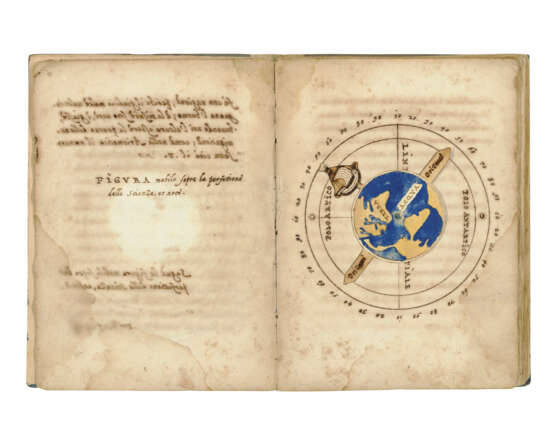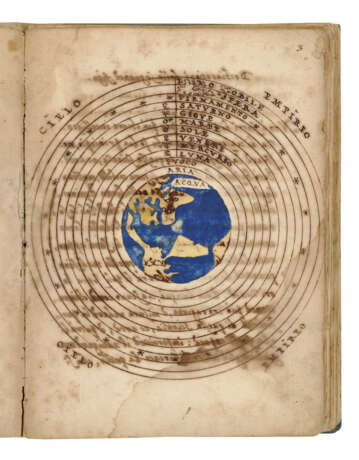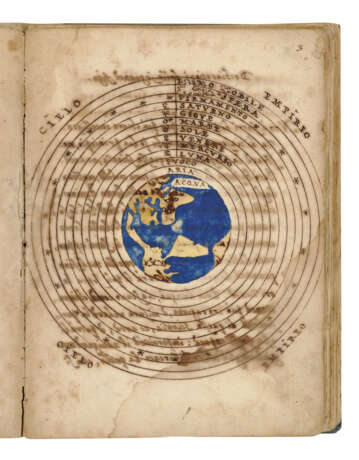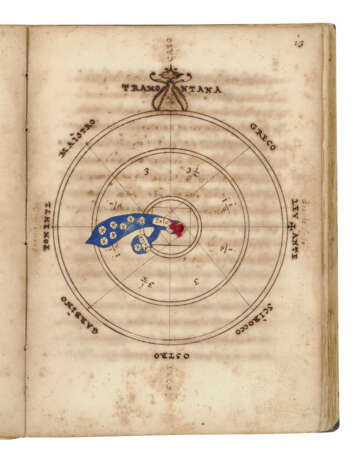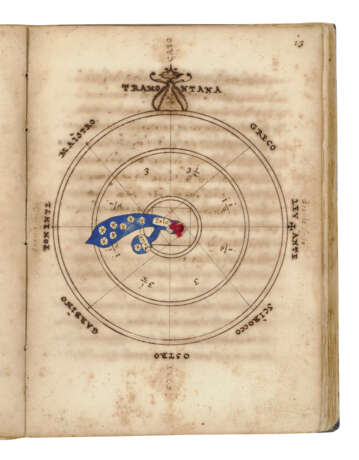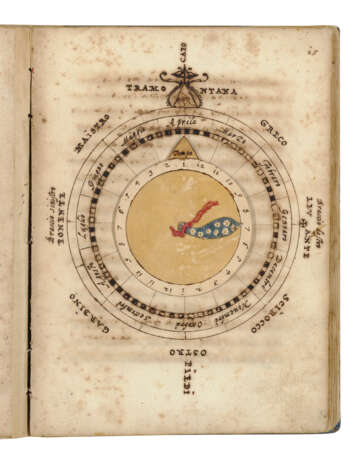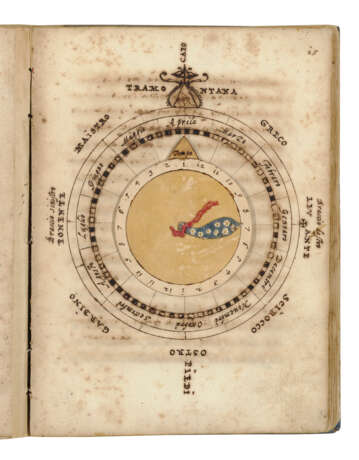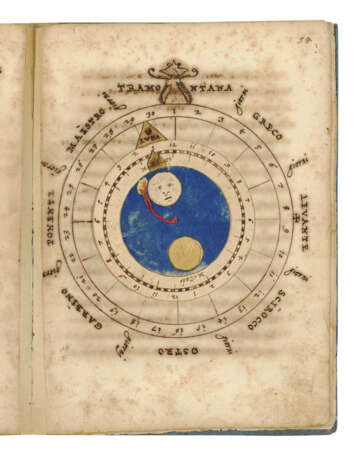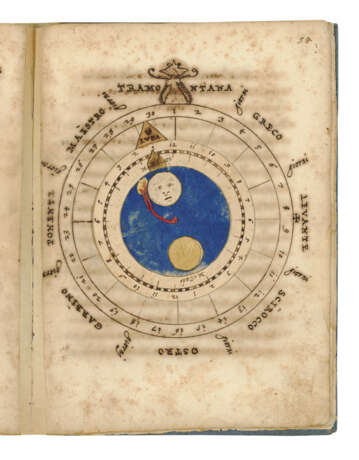ID 1449840
Lot 26 | Agostino Cesareo (fl. second half 16th century)
Valeur estimée
£ 25 000 – 30 000
L'arte del navigare, in Italian, autograph illustrated dedication copy for Annibale de Grassi, manuscript on paper [Italy], 1577.
An unrecorded autograph presentation copy to the Apostolic Nuncio to Spain, Annibale de Grassi, of Agostino Cesareo’s treatise on navigation, composed at the height of the Age of Exploration, with exceptional, intact, working volvelles.
210 x 155mm. i + 68 leaves, complete, contemporary foliation 1-65 followed here, vertical catchwords survive, 18 lines, written space: 150 x 120mm, 10 diagrams, including 4 coloured volvelles with moving parts (considerable ink erosion affecting the text and some of the diagrams, some marginal staining and spotting, the gutters reinforced, the volvelles and maps generally in good condition). Binding of 19th-century pasteboards.
Provenance:
(1) Agostino Cesareo, presentation copy to Annibale de Grassi (1537-1590), Roman Catholic prelate who served as Apostolic Nuncio to Spain (1588–1590) and Bishop of Faenza (1575–1585).
(2) Felice Meandri, of Ancarano: 19th-century ownership inscription in pen on f.i dated 2 January 1873.
(3) Ex Libris Huck: armorial bookplate pasted on inner cover. The bookplate shows a view of the Frankfurt Rathaus.
Content: Dedicatory preface: ‘Al molto illustre e R[everendissi]mo Monsignor Anibale de Grassi. Vescovo di Faenza. Agostino Cesareo Romano’, dated 1577, ff.ii-ii verso; ‘L'arte del navigare con il regimento della Tramontana e del sole, e la vera regola, et osservanza del flusso e reflusso delle Acque, sotto breve compendio nuovamente ridotta per Agostino Cesareo’ ff.1-65.F
Cesareo's treatise is divided into three parts: the first (ff.1-20) deals with cosmographical and navigational definitions (Altura, Grado, Orizonte, Hemisperio, etc.), and explains how to navigate by the North Star (Polo Artico), how to make and use the cross-staff ('balestrina'), the movement of Ursa Minor, how to calculate the hours of the night and how to navigate by the Southern Cross. The second part (ff.20v-43) discusses the height of the sun ('l'altura del sole'), with corresponding tables of declination of the sun, how to count ('Quattro dita fa una mano / Quattro mani fanno un piedie / Cinque piedi fanno un passo / Mille passi fanno un miglio', etc.), how to navigate crosswinds, a meridian list of cities and locations (Tripoli, Messina, Sardinia, Almeria) with quarter-hour deviations, and how to navigate by longitude from East to West ('Regola della navigatione da Levante in Ponente per longitudine'). The third part (ff.44-65) begins with the influence of the moon on the tides, and provides a long descriptive list of the tides and currents in Spain, Portugal, Galicia, Brittany, Normandy, Picardy, Flanders, Holland, the English Channel, the Strait of Messina, Venice, etc. The treatise ends with a table of latitudes in the Mediterranean 'Altura di latitudine di tutto il Mare mediterraneo') and a discussion on the motions of the moon, Mercury, Venus, the Sun, Jupiter, and Saturn. Each volvelle in the manuscript elegantly and colourfully illustrates simple mathematical calculations (for an account of the function of Renaissance volvelles see S. Karr, ‘Constructions Both Sacred and Profane: Serpents, Angels, and Pointing Fingers in Renaissance Books with Moving Parts,’ Yale University Library Gazette 78.3-4 (2004), pp.101–27).
For an extensive discussion of the text of this manuscript and the surviving copies see C. van Duzer, ‘Agostino Cesareo’s Treatise on Navigation and the Quest for publication in print: Princeton’s Kane MS.54’, The Princeton University Library Chronicle, Vol. 76, No 3 (2015), pp. 533-568. Van Duzer records 20 autograph manuscript copies of Cesareo’s L’Arte del navigare, 15 of which are dated and dedicated to various European nobles. The present manuscript is not recorded. These are: Amsterdam, Het Scheepvaartmuseum, Mi-83-0277; Greenwich, National Maritime Museum, nvt/25; Vienna, Österreichische Nationalbibliothek, Cod. 10,779; Florence, Biblioteca Nazionale Centrale, Palat. 734; New Haven, Beinecke Rare Book and Manuscript Library, Ms. 562; five at the Vatican: Biblioteca Apostolica Vaticana, Ms. Urb. lat. 1423, 1436, Fondo Patetta 260, Mss. Vat. lat. 5360/8097 and 10334; two in London, British Library, Add. Ms. 25882 and 29255; Naples, Biblioteca nazionale Vittorio Emanuele III, Nazionale, Ms. xii.d.46; Milan, Biblioteca Ambrosiana, Ms. l 7 sup; Ferrara, Biblioteca Comunale Ariostea, Classe ii 437; Princeton, Princeton University Library, Kane Ms. 54; Siena, Biblioteca Comunale degli Intronati, Ms. l.vi.41; one for sale in 2014-2015 by Antiquariat Inlibris Gilhofer Nfg. GmbH, Vienna, formerly in the collection of the Johns Hopkins historian Frederic C. Lane (1900–1984); Washington, D.C., Library of Congress, Mss. 32516; Osimo, Biblioteca di Palazzo Campana, Ms. 18L13.
'The surviving manuscripts of Cesareo’s treatise on navigation furnish the material for an intriguing study of an author’s use of dedications and gift manuscripts in sixteenth-century Italy. Cesareo dedicated his work to nobles up and down the Italian peninsula and also to potential patrons in Germany, Spain, and France [...] The list of dedicatees is also notable for the preponderance of second- and third-tier nobles, aside from Cosimo I de’ Medici and Francesco Maria II della Rovere [and Annibale de Grassi himself, dedicatee of the present manuscript]. Cesareo was apparently struggling with a poor network of contacts. The widely scattered domains of those nobles make it inconceivable that Cesareo’s goal was to further his political career in Rome' (C. van Duzer, p.550). Van Duzer points out the peculiar fact that not a single one of Cesareo's dedicatees had his principle residence in a port city, and only one had any connection with maritime affairs, which makes it unlikely that he was seeking appointment as a court navigator or cosmographer. The most likely explanation for the flurry of autograph copies of Cesareo's navigational treatise dedicated to nobles scattered across the continent is that he was seeking a patron to get his work printed.
The subjects of the diagrams and volvelles are as follows:
f.3: the world surrounded by the planetary spheres
f.5: volvelle with map of the earth and horizon for determining a ship’s latitude, which will equal the number of degrees that the Pole Star or Southern Cross is above the horizon; the index of the moving part is a picture of a medieval one-masted ship.
f.9: diagram of a balestrina, for navigational purposes.
13: volvelle showing the position of the North Star with respect to the north celestial pole; the moveable hand representing Ursa Minor.
f.15: volvelle with the horgologium nocturnum or nocturnal, an instrument for determining the time at night; the moveable hand representing Ursa Minor.
f.20: diagram showing the Antarctic pole (‘Il crucero overo la croce imagine’)
f.38: compass-card (‘Ragione della navigatione per li venti obliqui’)
f.38v: diagram (‘Obliquita’ de’ venti per navigare’)
f.45: the Moon
f.58: volvelle to calculate the tides, with two moving parts (‘Figura mobile per sapere e conoscere le maree secondo la regola generale’).
| Lieu d'origine: | Italie, Europe |
|---|---|
| Catégorie maison de vente aux enchères: | Manuscrits médiévaux et de la Renaissance, Livres et manuscrits |
| Lieu d'origine: | Italie, Europe |
|---|---|
| Catégorie maison de vente aux enchères: | Manuscrits médiévaux et de la Renaissance, Livres et manuscrits |
| Adresse de l'enchère |
CHRISTIE'S 8 King Street, St. James's SW1Y 6QT London Royaume-Uni | |
|---|---|---|
| Aperçu |
| |
| Téléphone | +44 (0)20 7839 9060 | |
| Commission | see on Website | |
| Conditions d'utilisation | Conditions d'utilisation |
